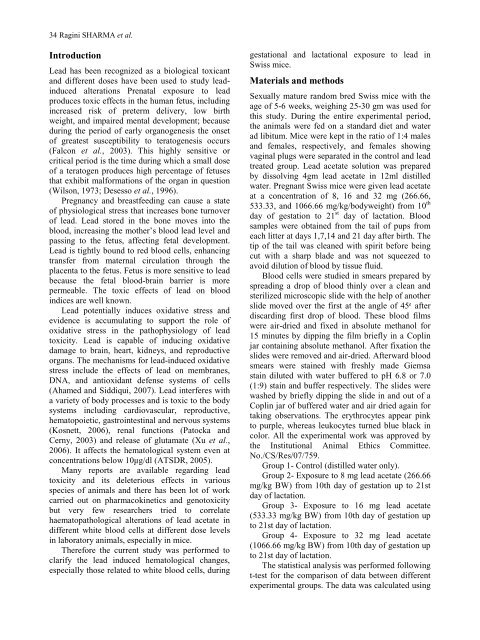10 1 Full Volume (PDF)(jcmb.halic.edu.tr) - Journal of Cell and ...
10 1 Full Volume (PDF)(jcmb.halic.edu.tr) - Journal of Cell and ...
10 1 Full Volume (PDF)(jcmb.halic.edu.tr) - Journal of Cell and ...
Create successful ePaper yourself
Turn your PDF publications into a flip-book with our unique Google optimized e-Paper software.
34Ragini SHARMA et al.<br />
In<strong>tr</strong>oduction<br />
Lead has been recognized as a biological toxicant<br />
<strong>and</strong> different doses have been used to study leadinduced<br />
alterations Prenatal exposure to lead<br />
produces toxic effects in the human fetus, including<br />
increased risk <strong>of</strong> preterm delivery, low birth<br />
weight, <strong>and</strong> impaired mental development; because<br />
during the period <strong>of</strong> early organogenesis the onset<br />
<strong>of</strong> greatest susceptibility to teratogenesis occurs<br />
(Falcon et al., 2003). This highly sensitive or<br />
critical period is the time during which a small dose<br />
<strong>of</strong> a teratogen produces high percentage <strong>of</strong> fetuses<br />
that exhibit malformations <strong>of</strong> the organ in question<br />
(Wilson, 1973; Desesso et al., 1996).<br />
Pregnancy <strong>and</strong> breastfeeding can cause a state<br />
<strong>of</strong> physiological s<strong>tr</strong>ess that increases bone turnover<br />
<strong>of</strong> lead. Lead stored in the bone moves into the<br />
blood, increasing the mother’s blood lead level <strong>and</strong><br />
passing to the fetus, affecting fetal development.<br />
Lead is tightly bound to red blood cells, enhancing<br />
<strong>tr</strong>ansfer from maternal circulation through the<br />
placenta to the fetus. Fetus is more sensitive to lead<br />
because the fetal blood-brain barrier is more<br />
permeable. The toxic effects <strong>of</strong> lead on blood<br />
indices are well known.<br />
Lead potentially induces oxidative s<strong>tr</strong>ess <strong>and</strong><br />
evidence is accumulating to support the role <strong>of</strong><br />
oxidative s<strong>tr</strong>ess in the pathophysiology <strong>of</strong> lead<br />
toxicity. Lead is capable <strong>of</strong> inducing oxidative<br />
damage to brain, heart, kidneys, <strong>and</strong> reproductive<br />
organs. The mechanisms for lead-induced oxidative<br />
s<strong>tr</strong>ess include the effects <strong>of</strong> lead on membranes,<br />
DNA, <strong>and</strong> antioxidant defense systems <strong>of</strong> cells<br />
(Ahamed <strong>and</strong> Siddiqui, 2007). Lead interferes with<br />
a variety <strong>of</strong> body processes <strong>and</strong> is toxic to the body<br />
systems including cardiovascular, reproductive,<br />
hematopoietic, gas<strong>tr</strong>ointestinal <strong>and</strong> nervous systems<br />
(Kosnett, 2006), renal functions (Patocka <strong>and</strong><br />
Cerny, 2003) <strong>and</strong> release <strong>of</strong> glutamate (Xu et al.,<br />
2006). It affects the hematological system even at<br />
concen<strong>tr</strong>ations below <s<strong>tr</strong>ong>10</s<strong>tr</strong>ong>μg/dl (ATSDR, 2005).<br />
Many reports are available regarding lead<br />
toxicity <strong>and</strong> its deleterious effects in various<br />
species <strong>of</strong> animals <strong>and</strong> there has been lot <strong>of</strong> work<br />
carried out on pharmacokinetics <strong>and</strong> genotoxicity<br />
but very few researchers <strong>tr</strong>ied to correlate<br />
haematopathological alterations <strong>of</strong> lead acetate in<br />
different white blood cells at different dose levels<br />
in laboratory animals, especially in mice.<br />
Therefore the current study was performed to<br />
clarify the lead induced hematological changes,<br />
especially those related to white blood cells, during<br />
gestational <strong>and</strong> lactational exposure to lead in<br />
Swiss mice.<br />
Materials <strong>and</strong> methods<br />
Sexually mature r<strong>and</strong>om bred Swiss mice with the<br />
age <strong>of</strong> 5-6 weeks, weighing 25-30 gm was used for<br />
this study. During the entire experimental period,<br />
the animals were fed on a st<strong>and</strong>ard diet <strong>and</strong> water<br />
ad libitum. Mice were kept in the ratio <strong>of</strong> 1:4 males<br />
<strong>and</strong> females, respectively, <strong>and</strong> females showing<br />
vaginal plugs were separated in the con<strong>tr</strong>ol <strong>and</strong> lead<br />
<strong>tr</strong>eated group. Lead acetate solution was prepared<br />
by dissolving 4gm lead acetate in 12ml distilled<br />
water. Pregnant Swiss mice were given lead acetate<br />
at a concen<strong>tr</strong>ation <strong>of</strong> 8, 16 <strong>and</strong> 32 mg (266.66,<br />
533.33, <strong>and</strong> <s<strong>tr</strong>ong>10</s<strong>tr</strong>ong>66.66 mg/kg/bodyweight) from <s<strong>tr</strong>ong>10</s<strong>tr</strong>ong> th<br />
day <strong>of</strong> gestation to 21 st day <strong>of</strong> lactation. Blood<br />
samples were obtained from the tail <strong>of</strong> pups from<br />
each litter at days 1,7,14 <strong>and</strong> 21 day after birth. The<br />
tip <strong>of</strong> the tail was cleaned with spirit before being<br />
cut with a sharp blade <strong>and</strong> was not squeezed to<br />
avoid dilution <strong>of</strong> blood by tissue fluid.<br />
Blood cells were studied in smears prepared by<br />
spreading a drop <strong>of</strong> blood thinly over a clean <strong>and</strong><br />
sterilized microscopic slide with the help <strong>of</strong> another<br />
slide moved over the first at the angle <strong>of</strong> 45ᵒ after<br />
discarding first drop <strong>of</strong> blood. These blood films<br />
were air-dried <strong>and</strong> fixed in absolute methanol for<br />
15 minutes by dipping the film briefly in a Coplin<br />
jar containing absolute methanol. After fixation the<br />
slides were removed <strong>and</strong> air-dried. Afterward blood<br />
smears were stained with freshly made Giemsa<br />
stain diluted with water buffered to pH 6.8 or 7.0<br />
(1:9) stain <strong>and</strong> buffer respectively. The slides were<br />
washed by briefly dipping the slide in <strong>and</strong> out <strong>of</strong> a<br />
Coplin jar <strong>of</strong> buffered water <strong>and</strong> air dried again for<br />
taking observations. The erythrocytes appear pink<br />
to purple, whereas leukocytes turned blue black in<br />
color. All the experimental work was approved by<br />
the Institutional Animal Ethics Committee.<br />
No./CS/Res/07/759.<br />
Group 1- Con<strong>tr</strong>ol (distilled water only).<br />
Group 2- Exposure to 8 mg lead acetate (266.66<br />
mg/kg BW) from <s<strong>tr</strong>ong>10</s<strong>tr</strong>ong>th day <strong>of</strong> gestation up to 21st<br />
day <strong>of</strong> lactation.<br />
Group 3- Exposure to 16 mg lead acetate<br />
(533.33 mg/kg BW) from <s<strong>tr</strong>ong>10</s<strong>tr</strong>ong>th day <strong>of</strong> gestation up<br />
to 21st day <strong>of</strong> lactation.<br />
Group 4- Exposure to 32 mg lead acetate<br />
(<s<strong>tr</strong>ong>10</s<strong>tr</strong>ong>66.66 mg/kg BW) from <s<strong>tr</strong>ong>10</s<strong>tr</strong>ong>th day <strong>of</strong> gestation up<br />
to 21st day <strong>of</strong> lactation.<br />
The statistical analysis was performed following<br />
t-test for the comparison <strong>of</strong> data between different<br />
experimental groups. The data was calculated using
















